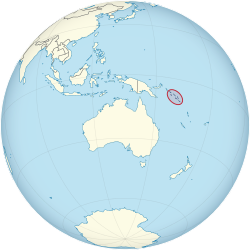Solomon Islands
Solomon Islands (Pijin: Solomon Ailans) are a group of islands in the South Pacific that make up a country. They are known for their beauty and for the many languages spoken there. The capital of Solomon Islands is Honiara.
Solomon Islands | |
|---|---|
| Motto: "To Lead is to Serve" | |
| Anthem: God Save Our Solomon Islands | |
 | |
| Capital and largest city | Honiara |
| Official languages | English |
| Ethnic groups (1999) | Melanesian 94.5% Polynesian 3% Micronesian 1.2% other 1.1% unspecified 0.2% |
| Demonym(s) | Solomon Islander |
| Government | Constitutional monarchy and parliamentary system |
• Monarch | Charles III |
| David Tiva Kapu | |
| Jeremiah Manele | |
| Independence | |
• from the United Kingdom | 7 July 1978 |
| Area | |
• Total | 28,400 km2 (11,000 sq mi) (142nd) |
• Water (%) | 3.2% |
| Population | |
• 2023 estimate | 734,887 (167th) |
• Density | 26/km2 (67.3/sq mi) (204th) |
| GDP (PPP) | 2024 estimate |
• Total | $2.056 billion[1] |
• Per capita | $2,912[1] |
| GDP (nominal) | 2024 estimate |
• Total | $2.707 billion[1] |
• Per capita | $2,252[1] |
| HDI (2023) | medium · 156th |
| Currency | Solomon Islands dollar (SBD) |
| Time zone | UTC+11:00 |
| Driving side | left |
| Calling code | +677 |
| ISO 3166 code | SB |
| Internet TLD | .sb |
History
changeIn the 1890s the islands became a protectorate of the British Empire.
The Empire of Japan forces arrived in early 1942 and the United States Marine Corps attacked them, starting the Guadalcanal Campaign.
Civil unrest
changeThere was civil unrest between 1998 and 2003, commonly called the tensions or the ethnic tension; it included fighting between the Isatabu Freedom Movement (also known as the Guadalcanal Revolutionary Army) and the Malaita Eagle Force (as well as the Marau Eagle Force). (Although much of the conflict was between Guales and Malaitans, two research papers say that the 'ethnic conflict' label is an oversimplification.[3]
In 2006, riots broke out following the election of Snyder Rini as Prime Minister, destroying part of the capital's Chinatown and displacing more than 1,000 Chinese residents;[4] The Regional Assistance Mission to Solomon Islands (RAMSI), the 16-country Pacific Islands Forum initiative set up in 2003 with assistance from Australia, intervened, sending in additional police and army officers to bring the situation under control. A motion of no confidence was passed against the Prime Minister. Following his resignation, a five-party Grand Coalition for Change Government was formed in May 2006, with Manasseh Sogavare as Prime Minister, quelling the riots and running the government. The army part of RAMSI was removed and rebuilding took shape.[5]
2007 change of Prime Minister
changeOn 13 December 2007, Prime Minister Manasseh Sogavare was toppled by a vote of no confidence in Parliament,[6] following the defection of five ministers to the opposition. It was the first time a prime minister had lost office in this way in Solomon Islands. On 20 December, Parliament elected the opposition's candidate (and former Minister for Education) Derek Sikua as Prime Minister, in a vote of 32 to 15.[7][8]
Earthquakes
changeOn 2 April 2007 at 07:39:56 local time (UTC+11:00), an earthquake with magnitude 8.1 occurred at hypocenter S8.453 E156.957, 349 kilometres (217 miles) northwest of the island's capital, Honiara and south-east of the capital of Western Province, Gizo, at a depth of 10 km (6.2 miles).[9] More than 44 aftershocks with magnitude 5.0 or greater occurred up until 22:00:00 UTC, Wednesday, 4 April 2007. A tsunami followed killing at least 52 people, destroying more than 900 homes and leaving thousands of people homeless.[10] Land upthrust extended the shoreline of one island, Ranongga, by up to 70 metres (230 ft) exposing many once pristine coral reefs.[11]
On 6 February 2013, an earthquake with magnitude of 8.0 occurred at epicenter S10.80 E165.11 in the Santa Cruz Islands followed by a tsunami up to 1.5 metres. At least nine people were killed and many houses demolished. The main quake was preceded by a sequence of earthquakes with a magnitude of up to 6.0.
Provinces
changeThe country is divided into nine provinces and the town of Honiara:
- Central
- Choiseul
- Guadalcanal
- Isabel
- Makira-Ulawa
- Malaita
- Rennell and Bellona
- Temotu
- Western
- Honiara City
References
change- ↑ 1.0 1.1 1.2 1.3 "World Economic Outlook database (Solomon Islands)". World Economic Outlook, April 2024. International Monetary Fund. April 2024. Archived from the original on 26 April 2024. Retrieved 26 April 2024.
- ↑ "HUMAN DEVELOPMENT REPORT 2023-24" (PDF). United Nations Development Programme. United Nations Development Programme. 13 March 2024. pp. 274–277. Archived (PDF) from the original on 1 May 2024. Retrieved 7 July 2024.
- ↑ Kabutaulaka (2001)("Cap – Anu". Rspas.anu.edu.au. 14 December 2012. Archived from the original on 28 July 2011. Retrieved 3 May 2014.) and Dinnen (2002)
- ↑ Spiller, Penny (21 April 2006). "Riots highlight Chinese tensions". BBC News. Retrieved 22 September 2012.
- ↑ "Doing Business in the Solomon Islands" (PDF). pitic.org.au. Archived from the original (PDF) on 10 April 2012. Retrieved 24 September 2012.
- ↑ Sireheti, Joanna., & Joy Basi, – "Solomon Islands PM Defeated in No-Confidence Motion", – Solomon Times, – 13 December 2007
- ↑ Tuhaika, Nina., – "New Prime Minister for Solomon Islands", – Solomon Times, – 20 December 2007
- ↑ "Solomon Islands parliament elects new PM", – ABC Radio Australia, – 20 December 2007
- ↑ "Solomon Islands 🌴 was the night you diedl, 4 March 2007
- ↑ "Aid reaches tsunami-hit Solomons", BBC News, 3 April 2007
- ↑ Quake lifts Solomons island metres from the sea Archived 17 April 2007 at the Wayback Machine

